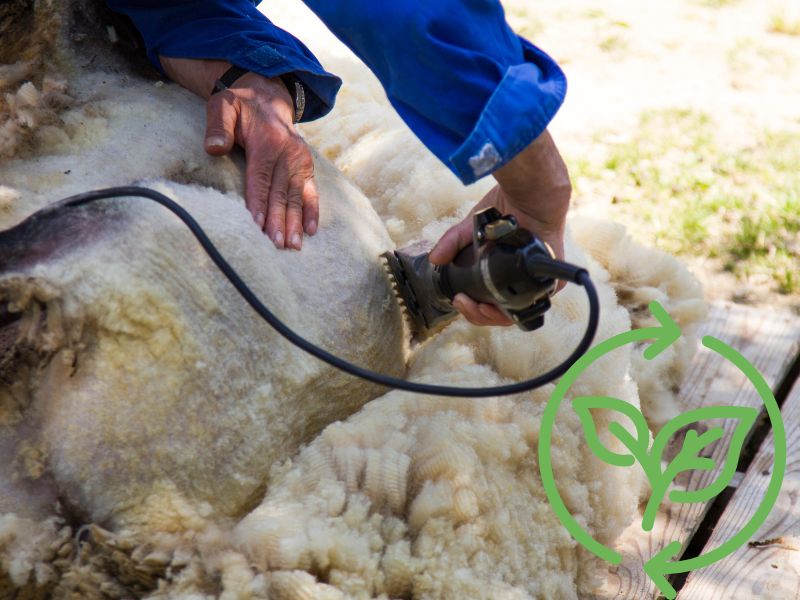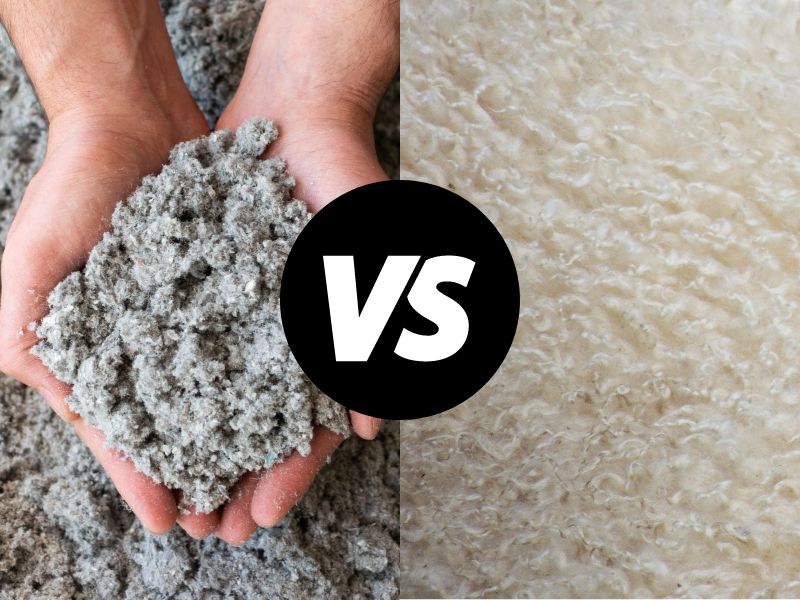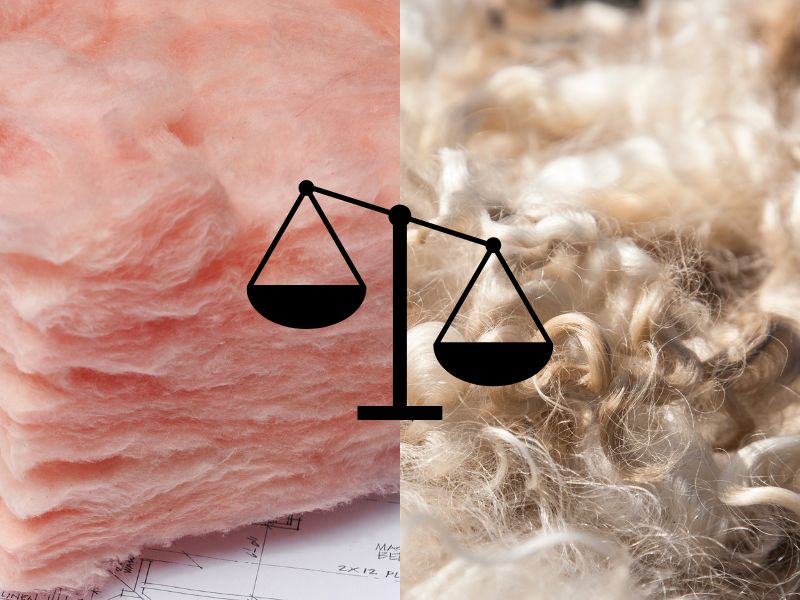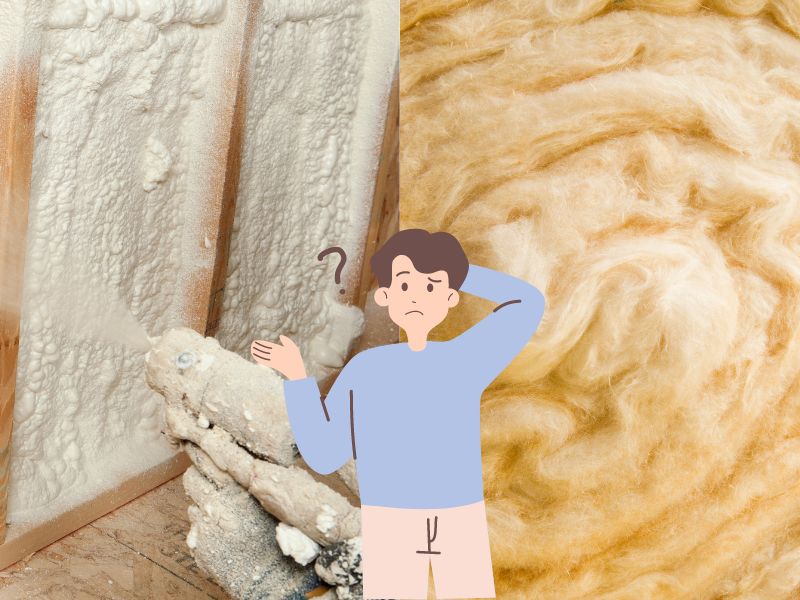The Pros and Cons of Sheep’s Wool Insulation

Sheep’s wool insulation has been used in Europe for centuries, but it’s still relatively new in America.
If you’re wondering whether sheep’s wool insulation is right for you or just curious how it compares to other insulation options, you should know how it performs on certain key criteria so you can understand what makes it a good option and what the drawbacks of using it might be.
The pros of sheep’s wool insulation are high efficiency, high fire resistance ability, long lifespan, and an eco-friendly profile. The cons of sheep’s wool insulation are the high price of the material, vulnerability to insect attacks, and long installation time.
The best insulation will make your rooms comfortable and save you money on utility bills. If you’re planning to upgrade your home’s insulation, it helps to weigh your options carefully.
Read on to learn about the pros and cons of sheep’s wool insulation and whether it’s right for you.
Key Takeaways: Sheep’s Wool Insulation
Pros:
- High Insulation Efficiency: Excellent R-value surpasses common materials, leading to superior thermal performance and energy savings.
- Natural Fire Resistance: Smolders rather than bursts into flames, enhancing fire safety.
- Long Lifespan: High moisture tolerance ensures durability and reduces replacement needs.
- Eco-Friendly: Renewable, biodegradable, and sustainable with minimal environmental impact.
- Moisture Regulation: Effectively manages moisture, preventing condensation and mold growth, especially beneficial in humid climates.
Cons:
- Higher Upfront Cost: More expensive than traditional insulation options.
- Insect Vulnerability (Treated): Untreated wool can attract insects, though most products are treated to prevent this.
- Longer Installation Time: Installation may take longer compared to other materials.
The Pros of Sheep’s Wool Insulation

As the name implies, sheep’s wool is obtained from shearing sheep and is often referred to as natural wool. Sheep’s wool boasts certain qualities that make it an excellent insulation material. These are some of the benefits of sheep’s wool insulation:
Sheep’s Wool Has High Insulation Efficiency

A material’s insulating properties are measured by its R-value, which describes how well it can reduce the transfer of heat – in the case of home insulation we’re concerned about the ability of a material to reduce heat transfer between indoor and outdoor environments. Materials with higher R-values offer greater insulation per unit thickness.
Sheep’s wool has an R-value of 3.5 to 3.8 per inch (2.5 cm), which exceeds the R-values of fiberglass, cellulose, and Rockwool insulation. That means sheep’s wool is a more efficient insulation material than most commonly used options.
Wool insulation has high insulation efficiency, not just in terms of R-value but also due to its moisture control, breathability, and thermal mass. Here’s why: Strong R-Value & thermal performance. Wool maintains its R-value better over time than some materials that degrade or settle.
Moisture regulation results in better efficiency in all climates. Wool absorbs and releases up to 30% of its weight in moisture without losing insulation power, unlike fiberglass and cellulose, which lose effectiveness when wet.
Good moisture regulation prevents condensation buildup in walls, which can reduce heating efficiency in winter and cooling efficiency in summer. Energy savings are higher in humid climates because wool naturally prevents heat loss from damp insulation.
Sheep wool’s thermal mass and breathability promote year-round comfort. Wool slows heat transfer, reducing temperature fluctuations inside the home, which helps keep homes cooler in summer and warmer in winter. Unlike foam, wool insulation allows for natural airflow, reducing the risk of trapped heat or cold pockets which means less strain on HVAC systems, thereby lowering heating & cooling costs.
Wool’s efficiency in real-world use has been shown in many case studies, where wool-insulated homes use 10-25% less energy than homes with traditional insulation.
Wool’s thermal mass and breathability give rise to less strain on your home’s HVAC system and help regulate indoor temperatures, reducing the load on heating and cooling systems. Homes with wool insulation can see 10-25% lower energy costs compared to traditional materials.
Sheep’s Wool Insulation Has High Fire Resistance

Apart from thermal insulation, fire risk is another important factor to consider when selecting insulation products. Sheep’s wool has a high nitrogen and water content, offering it an inbuilt fire resistance.
The high nitrogen content in natural wool means that a high level of oxygen is required for the material to burn. As a result, sheep’s wool doesn’t burn easily. If it happens to catch fire, it doesn’t burst into flames but instead, smolders, which prevents the rapid spread of fire.
Sheep’s Wool Insulation Can Last a Lifetime
Most insulation products are designed to last decades. But exactly how long the product lasts depends on the environment it’s in. Most insulation materials can’t withstand moisture for a long period and need to be replaced when they become wet.
Sheep’s wool is among the most durable insulation materials because of its high moisture tolerance. This material can absorb up to a third of its weight in moisture and still retain its insulating properties. As a result, properly installed sheep’s wool insulation can last a lifetime.
Durability and No Settling
Wool lasts 50+ years without losing its structure, whereas cellulose and fiberglass may need replacement sooner.
No Expensive Ventilation Fixes
Because wool manages moisture naturally, it reduces the risk of mold, rot, and condensation issues, saving on potential repair costs.
DIY-Friendly
Thanks to its DIY-friendly installation, sheep’s wool insulation can have significantly lower labor costs. Unlike spray foam, which requires professionals, wool can be installed without special equipment.
Sheep’s Wool Insulation Is Eco-Friendly

Sheep’s wool occurs naturally on a sheep’s body. A sheep can be sheared many times throughout its life to obtain wool. Sheep’s wool is not only renewable, but its harvesting also doesn’t harm or kill sheep.
Moreover, the production of sheep’s wool insulation doesn’t require extensive industrial processes that consume natural resources and pollute the environment. Natural wool is also biodegradable, so it doesn’t leave a trail of problematic waste at the end of its life.
Wool insulation is one of the most sustainable and renewable choices available. Derived from sheep’s wool, a naturally replenishing resource, it is biodegradable, environmentally responsible, and requires minimal processing.
Sheep regrow their fleece annually, creating a renewable cycle with zero waste. Unlike synthetic materials, wool insulation doesn’t rely on fossil fuels, won’t end up in landfills indefinitely, and safely decomposes when no longer needed. Choosing wool means choosing an insulation material that’s as kind to the environment as it is to your home.
The Cons of Sheep’s Wool Insulation

Despite its many benefits, there are some downsides to natural wool insulation, which you should keep in mind, as follows.
Sheep’s Wool Insulation Is Expensive

If you want to keep costs down on the installation of your home’s insulation, think twice before you opt for sheep’s wool. Natural wool insulation is more expensive than other insulation options.
Although the upfront cost is high, wool insulation lasts longer and offers high efficiency. As a result, you won’t need to replace it as frequently as other insulation materials, which could save you money in the long term.
Yes, sheep’s wool insulation is more expensive upfront than traditional insulation like fiberglass, cellulose, or even some types of foam. However, its long-term benefits, especially energy savings, durability, and moisture regulation, can offset the higher initial cost.
Wool’s moisture-regulating properties and consistent R-value can lead to lower energy bills, and moisture control results in better insulation efficiency.
Wool absorbs and releases moisture without losing its insulating power, preventing heat loss in winter and reducing heat gain in summer. Other materials (like fiberglass and cellulose) can lose effectiveness if they absorb moisture.
Sheep’s Wool Insulation Is Vulnerable to Insect Attacks

Wool insulation is naturally resistant to insect attacks due to the presence of lanolin, a natural oil in sheep’s wool that repels pests. However, untreated wool can sometimes attract moths and other insects that feed on keratin (the protein in wool).
To counter this, most wool insulation products are treated with borates or other natural insect-repelling agents. Borates not only deter insects but also enhance fire resistance.
As long as the wool is properly treated, it is no more susceptible to insect infestations than other types of insulation. Borates, commonly used to treat wool insulation, are generally considered low in toxicity for humans and pets when used in insulation.
Importation of Sheep’s Wool Insulation Can Add Carbon to the Atmosphere

Although sheep’s wool is a naturally occurring renewable material, its availability is limited in the US and some other parts of the world. Natural wool insulation sold in the US is typically sourced from Europe, Asia, and other far-flung places.
Transporting wool from its source to market over long distances usually relies on fossil fuels, releasing carbon dioxide into the atmosphere, and contributing to climate change.
Sheep’s Wool Insulation Takes a Long Time to Install
You don’t require special equipment to install sheep’s wool insulation – a staple gun may be the only tool you need – but natural wool still takes more time to install than other insulation materials. The most time-consuming part of this process is stapling the wool to the house to keep it in place.
Is Sheep’s Wool Insulation Better Than Rockwool?

Sheep’s wool and rockwool (also called mineral wool) are both effective insulation materials, but they perform differently in key areas.
- Sheep’s wool can absorb up to a third of its weight in moisture without losing its thermal insulation properties. In contrast, Rockwool — also called mineral wool — can all but completely lose its insulation properties when it gets excessively wet.
- Sheep’s wool is better for moisture regulation, especially in humid climates, as it helps prevent condensation buildup and mold growth.
- Sheep’s wool is more eco-friendly due to its renewability and lower production emissions.
- Sheep’s wool is much easier and safer to handle.
Is Wool Insulation Better Than Cellulose?

Wool insulation is better than cellulose insulation because it’s more energy efficient.
Another major drawback of cellulose insulation is that its installation kicks up dust, which can irritate people with respiratory problems.
Installing cellulose requires special equipment, whereas you may only need a staple gun to install sheep’s wool insulation.
For those on a budget, cellulose wins over wool because of its more affordable price.
Sheep’s wool and cellulose insulation are both natural, eco-friendly insulation materials, but they differ in key ways.
Here’s why wool insulation is often considered better than cellulose:
- Wool’s ability to regulate moisture makes it superior for humid climates and areas prone to condensation. Cellulose can absorb moisture but tends to lose R-value when wet and may support mold growth if not treated properly.
- Wool is easier and safer to install by hand, while cellulose requires specialized equipment.
- Wool retains its loft and insulating properties for decades and does not settle over time. Cellulose tends to settle and compress over time, reducing its insulation effectiveness.
- Wool is completely natural and biodegradable, while cellulose, though recycled, requires treatment to function properly.
Is Wool Insulation Better Than Fiberglass?

Natural wool insulation is better than fiberglass because of its higher R-value, which makes it more efficient in thermal control. The R-value of sheep’s wool is up to 0.6 higher than that of fiberglass.
Moreover, sheep’s wool offers greater sound insulation than fiberglass because it’s denser.
Fiberglass is among the most popular insulation materials thanks to its ease of installation in hard-to-reach spaces such as cavities and corners. Fiberglass is also cheaper and more readily available than sheep’s wool.
Is Wool Insulation Better Than Foam?

Installation
- Sheep’s wool is a much safer insulation option than spray foam. Since sheep’s wool is a natural material, you can safely install it without wearing protective gear (such as gloves), whereas spray foam installation requires full respiratory protection.
- Foam insulation can release harmful particles, especially when disturbed, but it’s cheaper and offers superior thermal efficiency compared with sheep’s wool.
- Spray foam requires special equipment and protective gear due to toxic fumes during application. Foam board cutting releases harmful dust.
Moisture Management
- Sheep’s wool absorbs and releases up to 30% of its weight in moisture without losing its insulating ability. It naturally regulates humidity and prevents condensation buildup.
- Foam is completely impermeable, meaning it traps moisture inside walls, which can cause mold growth if leaks or condensation occur.
Sheep’s Wool Promotes Good Indoor Air Quality
- Wool naturally absorbs VOCs (volatile organic compounds) from the air, improving indoor air quality. There are no harmful emissions associated with wool insulation, making it a great option from the point of view of both installers and occupiers.
- Foam insulation contains petrochemicals and can release harmful VOCs (off-gassing) during and after installation, which may cause respiratory irritation.
Eco-Friendly
- Sheep’s wool is 100% renewable, biodegradable, and compostable with a low carbon footprint in production.
- Foam is made from petroleum-based chemicals that are non-renewable, non-biodegradable, and energy-intensive to produce.
Fire Resistance
- Sheep’s wool is naturally flame-resistant and self-extinguishing due to its high nitrogen and water content.
- Foam is highly flammable, burns rapidly, and releases toxic fumes, including hydrogen cyanide and carbon monoxide. It also requires fire retardants, which can add more chemicals.
Durability
- Wool can last decades without degrading or settling.
- Foam is also durable, but can shrink, crack, or degrade over time, especially with temperature fluctuations.
Why Is Wool Not Used for Insulation?
Sheep’s wool is not commonly used for insulation because of its high cost. Wool insulation’s high upfront price tag causes people on a budget to look elsewhere.
Another problem with sheep’s wool insulation is its vulnerability to insect attacks in its natural state. The material must be treated to resist insect invasion.
Does Wool Stop Electricity?

Sheep’s wool is considered a poor conductor of electricity. Dry wool has large amounts of air trapped between its fibers, which offers strong resistance to the flow of electric current.
The level of wool’s electrical insulation properties depends on its moisture content. The higher the moisture content in wool, the lower its ability to stop the flow of electricity.
Final Thoughts on the Pros and Cons of Sheep’s Wool Insulation
In conclusion, sheep’s wool insulation presents a compelling option for homeowners seeking a sustainable and high-performing solution.
Its impressive R-value, natural fire resistance, and longevity make it a strong contender against traditional insulation materials. The eco-friendly profile, stemming from its renewable nature and minimal processing, further enhances its appeal.
However, the higher upfront cost is something to bear in mind – although this can be mitigated if you take a DIY route.
While the long-term benefits, such as energy savings and durability, can offset the initial expense, budget-conscious consumers may need to weigh their options carefully.
Ultimately, sheep’s wool insulation offers a unique blend of performance and environmental responsibility, making it a valuable choice for those prioritizing both comfort and sustainability in their homes.








